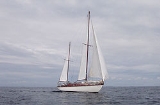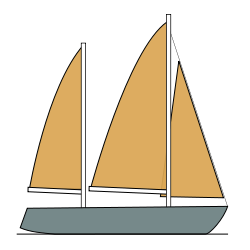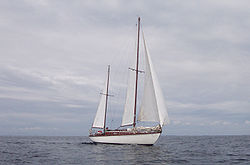
Ketch
Encyclopedia


Sailing
Sailing is the propulsion of a vehicle and the control of its movement with large foils called sails. By changing the rigging, rudder, and sometimes the keel or centre board, a sailor manages the force of the wind on the sails in order to move the boat relative to its surrounding medium and...
craft
Craft
A craft is a branch of a profession that requires some particular kind of skilled work. In historical sense, particularly as pertinent to the Medieval history and earlier, the term is usually applied towards people occupied in small-scale production of goods.-Development from the past until...
with two masts
Mast (sailing)
The mast of a sailing vessel is a tall, vertical, or near vertical, spar, or arrangement of spars, which supports the sails. Large ships have several masts, with the size and configuration depending on the style of ship...
: a main mast, and a shorter mizzen mast abaft (rearward) of the main mast, but forward of the rudder post. (When the mizzen mast is located aft of the rudder post, the vessel is called a yawl
Yawl
A yawl is a two-masted sailing craft similar to a sloop or cutter but with an additional mast located well aft of the main mast, often right on the transom, specifically aft of the rudder post. A yawl (from Dutch Jol) is a two-masted sailing craft similar to a sloop or cutter but with an...
.) Both masts are rigged mainly fore-and-aft
Fore-and-aft rig
A fore-and-aft rig is a sailing rig consisting mainly of sails that are set along the line of the keel rather than perpendicular to it. Such sails are described as fore-and-aft rigged....
. From one to three jib
Jib
A jib is a triangular staysail set ahead of the foremast of a sailing vessel. Its tack is fixed to the bowsprit, to the bow, or to the deck between the bowsprit and the foremost mast...
s may be carried forward of the main mast when going to windward. If a ketch is not rigged for jibs it is called a cat ketch, sometimes called a periauger. On older, larger ketches the main mast may in addition carry one or more square rig
Square rig
Square rig is a generic type of sail and rigging arrangement in which the primary driving sails are carried on horizontal spars which are perpendicular, or square, to the keel of the vessel and to the masts. These spars are called yards and their tips, beyond the last stay, are called the yardarms...
ged topsail
Topsail
A topsail is a sail set above another sail; on square-rigged vessels further sails may be set above topsails.- Square rig :On a square rigged vessel, a topsail is a square sail rigged above the course sail and below the topgallant sail where carried...
s. A ketch may also carry extra sails
Extra (sailing)
In sailing, an extra is a sail that is not part of the working sail plan.The most common extra is the spinnaker. Other extras include studding sails, the modern spanker , and some staysails and topsails....
, see below.
The lowest fore-and-aft sail on the main mast is called the mainsail
Mainsail
A mainsail is a sail located behind the main mast of a sailing vessel.On a square rigged vessel, it is the lowest and largest sail on the main mast....
, while that on the mizzen is called the mizzen sail. These may be any type of fore-and-aft sail, in any combination. The Scots Zulu, for example, had a dipping lug main with a standing lug mizzen.
The ketch is popular among long distance cruisers as the additional sail allows for a better balance, and a smaller more easily handled mainsail for the same overall sail area. It also allows sailing on mizzen and jib only without introducing excessive lee helm, and in an emergency can be quite well steered without use of the rudder. The ketch is a popular rig in northern European waters where sudden increases in wind strength sometimes require a rapid reefing: the mainsail can be dropped, reducing sail and leaving a balanced sail-plan with jib and mizzen set.
Running before the wind or reaching across the wind, a ketch may carry extra sails
Extra (sailing)
In sailing, an extra is a sail that is not part of the working sail plan.The most common extra is the spinnaker. Other extras include studding sails, the modern spanker , and some staysails and topsails....
such as a spinnaker
Spinnaker
A spinnaker is a special type of sail that is designed specifically for sailing off the wind from a reaching course to a downwind, i.e. with the wind 90°–180° off the bow. The spinnaker fills with wind and balloons out in front of the boat when it is deployed, called flying. It is constructed of...
on the main mast, and a spinnaker
Spinnaker
A spinnaker is a special type of sail that is designed specifically for sailing off the wind from a reaching course to a downwind, i.e. with the wind 90°–180° off the bow. The spinnaker fills with wind and balloons out in front of the boat when it is deployed, called flying. It is constructed of...
or (mizzen staysail
Staysail
A staysail is a fore-and-aft rigged sail whose luff can be affixed to a stay running forward from a mast to the deck, the bowsprit or to another mast....
) on the mizzen mast.
Derivation of "ketch"
Ketch was a "catch" or fishing boat. (Ketch from Middle English cache, from cacchen, to catch; see catch. http://www.thefreedictionary.com/ketch)The mizzen is bigger to hold the bow (front) of a boat toward the wind and oncoming waves. The mainsail at the front of the boat would have been dropped and the mizzen trimmed tight on the centreline. Set up this way most boats will point directly into the wind in a reliable way. It is also possible to ease the mizzen slightly to allow the boat to move slowly forward.
In a fishing boat this attitude allows the nets to be handled without the boat becoming "broadsides" to the waves allowing them to break over the sides of the boat. Fishnets can then be handled without putting the boat at risk.
For enough sail area to propel a fishing boat the mizzen mast has to move forward toward the middle of the boat which allows its sail to be bigger without upsetting the sail balance or distribution.
A "Ketch Rig" is simply the rig that matches the function of a "Ketch" or "Catch" or fishing boat.
Similar rigs
The ketch rig is often confused with a yawlYawl
A yawl is a two-masted sailing craft similar to a sloop or cutter but with an additional mast located well aft of the main mast, often right on the transom, specifically aft of the rudder post. A yawl (from Dutch Jol) is a two-masted sailing craft similar to a sloop or cutter but with an...
. The difference is that the ketch has her mizzen mast forward of the rudder post thus having more sail area, which contributes significant forward propulsion, whereas the mizzen on a yawl is aft of the rudder post and is used primarily to balance the sail plan (and as a riding sail while at anchor). This is often a matter of intent rather than a physical difference.
The ketch rig can be distinguished from the similar two masted schooner
Schooner
A schooner is a type of sailing vessel characterized by the use of fore-and-aft sails on two or more masts with the forward mast being no taller than the rear masts....
rig by the shorter aftermost mast on the ketch. A schooner has the shorter mast forward. In the case where both masts are approximately the same height, the rig with the larger sail forward is usually called a ketch, while the rig with the larger sail aft is a schooner.
Other variations include a cutter-rigged ketch. A cutter has a stay sail on a separate stay, forward of the main mast between the main sail and head sail. This sail plan can be adapted to a ketch.

